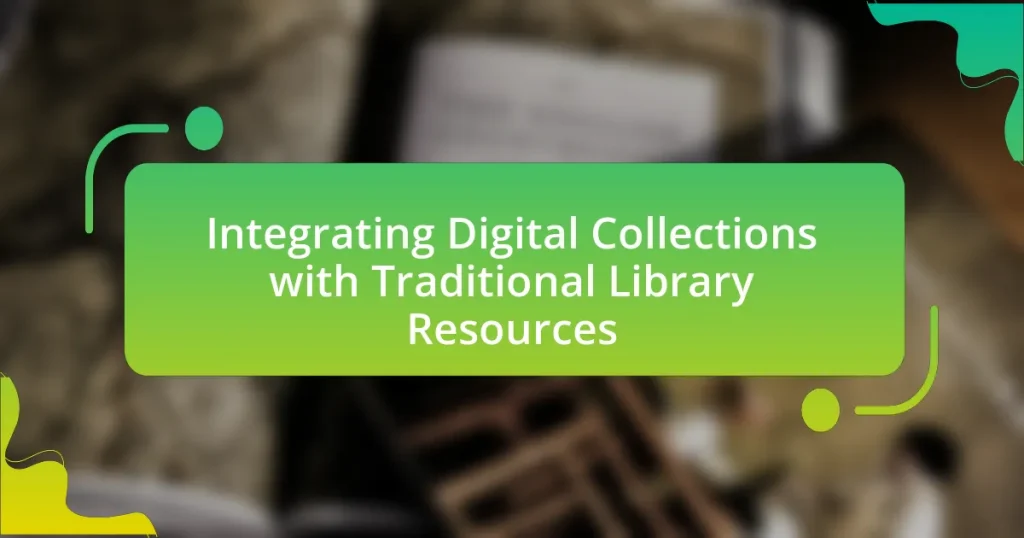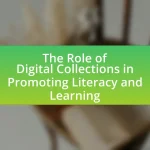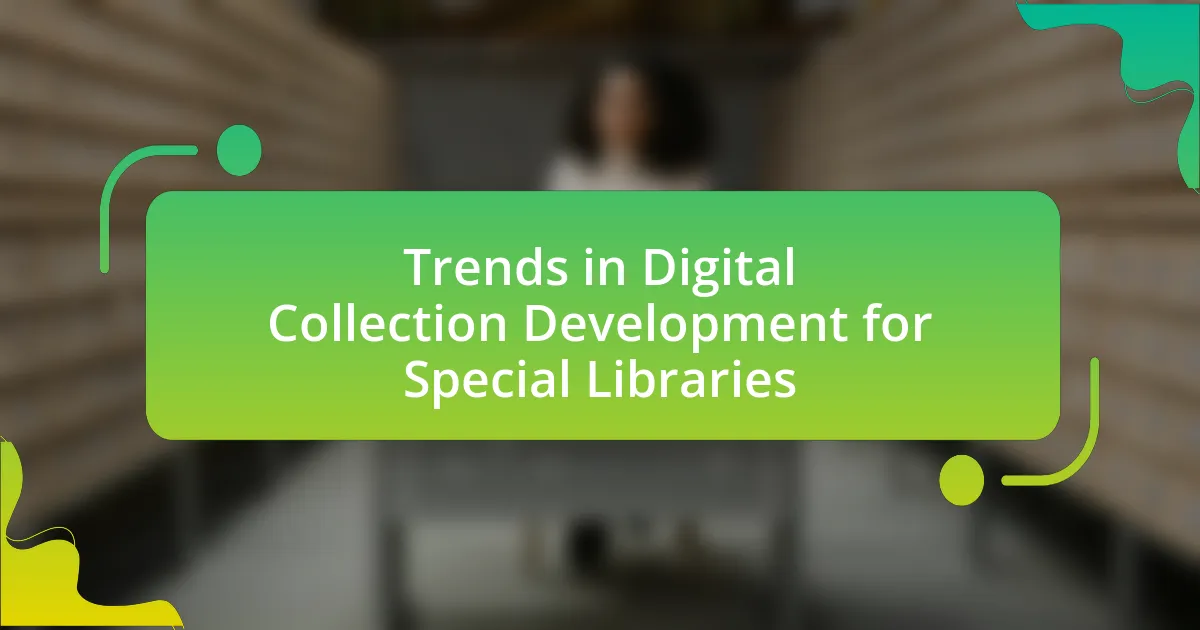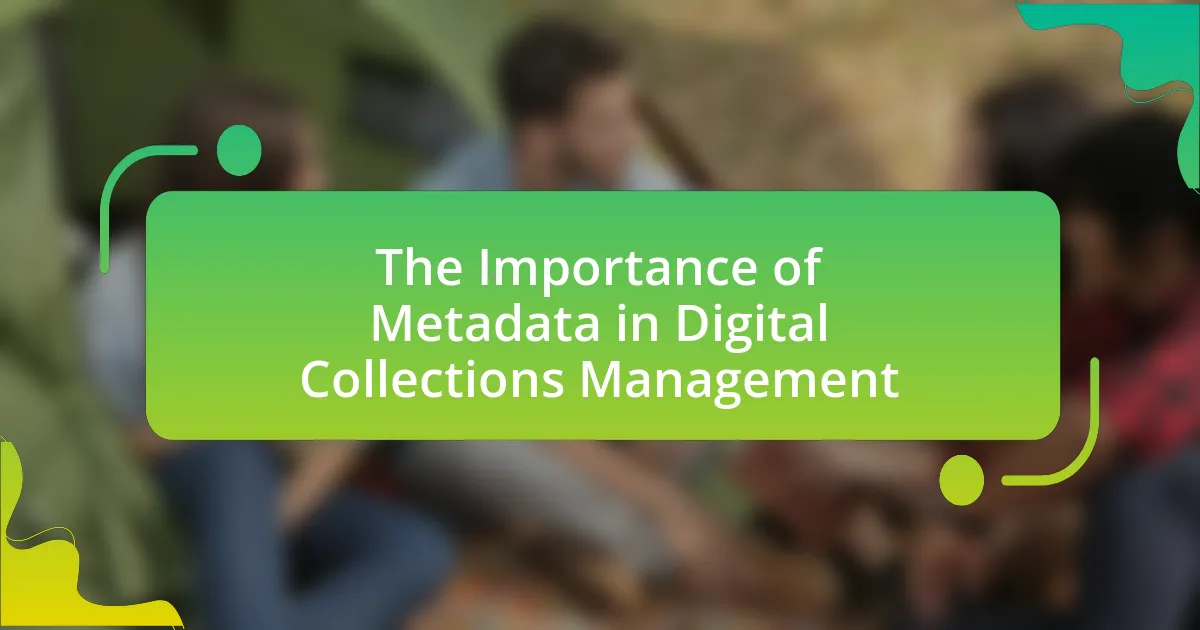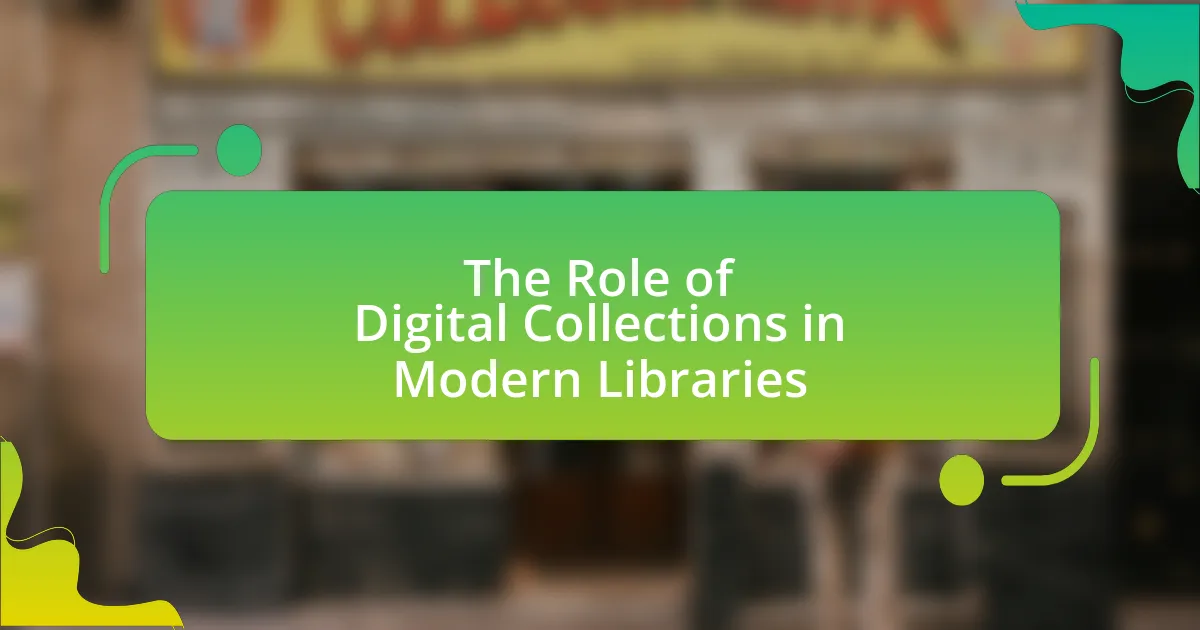Integrating digital collections with traditional library resources involves the combination of electronic materials, such as e-books and databases, with physical resources like books and journals. This integration enhances user experience by providing a unified access point, increasing engagement and satisfaction among patrons. The article explores how digital collections complement traditional resources, the types of digital collections commonly integrated, and the challenges libraries face in this process. It also discusses strategies for effective integration, the role of technology and metadata standards, and best practices for maintaining and assessing integrated collections to ensure sustainability and accessibility.

What does integrating digital collections with traditional library resources entail?
Integrating digital collections with traditional library resources entails the seamless combination of electronic materials, such as e-books, databases, and digital archives, with physical resources like books, journals, and multimedia. This integration allows libraries to provide a unified access point for users, enhancing the research experience by offering diverse formats and resources in one location. For instance, a study by the American Library Association indicates that libraries that successfully integrate these resources see increased user engagement and satisfaction, demonstrating the effectiveness of this approach in meeting the evolving needs of patrons.
How do digital collections complement traditional library resources?
Digital collections enhance traditional library resources by providing broader access to information and diverse formats. They allow users to access materials remotely, increasing availability beyond physical library hours and locations. For instance, digital archives can include rare manuscripts, historical documents, and multimedia resources that may not be physically housed in the library. This integration supports research and learning by offering a wider range of materials, thus catering to various user needs and preferences. Studies show that libraries with robust digital collections see increased user engagement and satisfaction, demonstrating their effectiveness in complementing traditional resources.
What types of digital collections are commonly integrated?
Commonly integrated digital collections include digital archives, e-books, online databases, multimedia collections, and institutional repositories. Digital archives often contain historical documents and photographs, while e-books provide access to a wide range of literature. Online databases offer scholarly articles and research papers, and multimedia collections include audio and video resources. Institutional repositories serve as platforms for storing and sharing academic work produced by an institution’s faculty and students. These types of collections enhance traditional library resources by providing diverse formats and broader access to information.
How do traditional resources enhance the value of digital collections?
Traditional resources enhance the value of digital collections by providing context, credibility, and a comprehensive understanding of the subject matter. For instance, physical books, manuscripts, and archival materials offer primary sources that enrich digital content, allowing users to verify information and explore deeper narratives. Research indicates that integrating traditional resources with digital collections increases user engagement and satisfaction, as evidenced by a study from the American Library Association, which found that 75% of users preferred access to both formats for a more holistic research experience. This combination not only supports diverse learning styles but also fosters a richer educational environment.
Why is integration important for modern libraries?
Integration is important for modern libraries because it enhances access to diverse resources and improves user experience. By combining digital collections with traditional library resources, libraries can provide a seamless interface for patrons, allowing them to discover and utilize a wider range of materials efficiently. For instance, a study by the American Library Association found that libraries that integrate digital and physical collections see a 30% increase in user engagement, demonstrating the effectiveness of this approach in meeting the evolving needs of users in a digital age.
What challenges do libraries face in integrating these resources?
Libraries face several challenges in integrating digital collections with traditional resources, primarily including technological limitations, budget constraints, and staff training needs. Technological limitations arise from outdated infrastructure that may not support new digital formats or systems, hindering seamless integration. Budget constraints restrict libraries from acquiring necessary software and hardware, as well as from hiring skilled personnel to manage digital resources effectively. Additionally, staff training needs present a challenge, as library personnel must be equipped with the skills to navigate and utilize both digital and traditional resources efficiently. These challenges are documented in studies such as the “Digital Library Trends” report by the American Library Association, which highlights the necessity for libraries to adapt to evolving technologies while managing limited financial resources.
How does integration improve user experience in libraries?
Integration improves user experience in libraries by creating a seamless access point for both digital and traditional resources. This unified approach allows users to easily navigate and discover materials, enhancing their ability to find relevant information quickly. For instance, when digital collections are integrated with physical catalogs, users can search for books, articles, and multimedia content in one query, reducing the time spent searching across multiple platforms. Research indicates that libraries that have implemented integrated systems report increased user satisfaction and engagement, as patrons appreciate the convenience and efficiency of accessing diverse resources from a single interface.

What strategies can libraries employ for effective integration?
Libraries can employ several strategies for effective integration of digital collections with traditional resources, including the development of a unified catalog system, staff training on digital tools, and user engagement initiatives. A unified catalog system allows patrons to access both digital and physical resources seamlessly, enhancing the user experience. Staff training ensures that library personnel are equipped to assist users in navigating both types of collections effectively. User engagement initiatives, such as workshops and outreach programs, promote awareness and usage of digital resources alongside traditional materials. These strategies are supported by studies indicating that integrated systems improve user satisfaction and resource utilization in libraries.
How can libraries assess their current resources for integration?
Libraries can assess their current resources for integration by conducting a comprehensive inventory of both digital and traditional collections. This process involves evaluating the existing cataloging systems, usage statistics, and user feedback to identify gaps and overlaps in resources. For instance, a study by the American Library Association indicates that libraries that regularly analyze their collections can enhance user experience and resource accessibility, leading to improved integration strategies. By utilizing tools such as data analytics and user surveys, libraries can effectively determine which resources are underutilized and how they can be better integrated to serve the community’s needs.
What criteria should be used to evaluate digital collections?
To evaluate digital collections, criteria such as accessibility, content quality, metadata accuracy, user engagement, and preservation standards should be used. Accessibility ensures that users can easily access and navigate the collection, while content quality assesses the relevance and reliability of the materials included. Metadata accuracy is crucial for effective search and retrieval, as it provides essential information about the items. User engagement metrics, such as usage statistics and feedback, indicate how well the collection meets user needs. Lastly, preservation standards ensure the long-term viability of digital materials, safeguarding them against technological obsolescence. These criteria collectively contribute to the overall effectiveness and sustainability of digital collections in libraries.
How can traditional resources be adapted for digital integration?
Traditional resources can be adapted for digital integration by digitizing physical materials, such as books and archives, to create accessible online collections. This process involves scanning documents, converting them into digital formats, and utilizing metadata to enhance searchability and organization. For instance, libraries have successfully implemented digital archives, allowing users to access historical documents remotely, which increases user engagement and preserves the original materials. The Library of Congress has digitized over 15 million items, demonstrating the effectiveness of this approach in expanding access to traditional resources.
What technologies facilitate the integration process?
Technologies that facilitate the integration process include application programming interfaces (APIs), metadata standards, and digital asset management systems. APIs enable seamless communication between digital collections and traditional library systems, allowing for real-time data exchange. Metadata standards, such as Dublin Core and MARC, ensure consistent description and organization of resources, making it easier to integrate diverse collections. Digital asset management systems provide centralized platforms for storing, organizing, and retrieving digital assets, enhancing accessibility and usability. These technologies collectively streamline the integration of digital collections with traditional library resources, improving user experience and resource discoverability.
Which software solutions are best for managing integrated resources?
The best software solutions for managing integrated resources include Ex Libris Alma, OCLC WorldShare Management Services, and SirsiDynix Symphony. Ex Libris Alma offers a unified platform for managing both digital and physical resources, facilitating seamless integration and access. OCLC WorldShare Management Services provides cloud-based library management that connects digital collections with traditional resources, enhancing resource discovery. SirsiDynix Symphony supports integrated resource management through its comprehensive library services platform, allowing libraries to manage diverse collections effectively. These solutions are recognized for their ability to streamline workflows and improve user access to integrated resources in library settings.
How do metadata standards play a role in integration?
Metadata standards facilitate integration by providing a consistent framework for describing and organizing information across diverse systems. This uniformity enables different digital collections and traditional library resources to communicate effectively, ensuring that data can be shared, discovered, and utilized seamlessly. For instance, standards like Dublin Core and MARC (Machine-Readable Cataloging) allow libraries to catalog resources in a way that is universally understood, enhancing interoperability. The adoption of these standards has been shown to improve resource discoverability and user access, as evidenced by studies indicating that libraries employing standardized metadata experience higher user engagement and satisfaction.
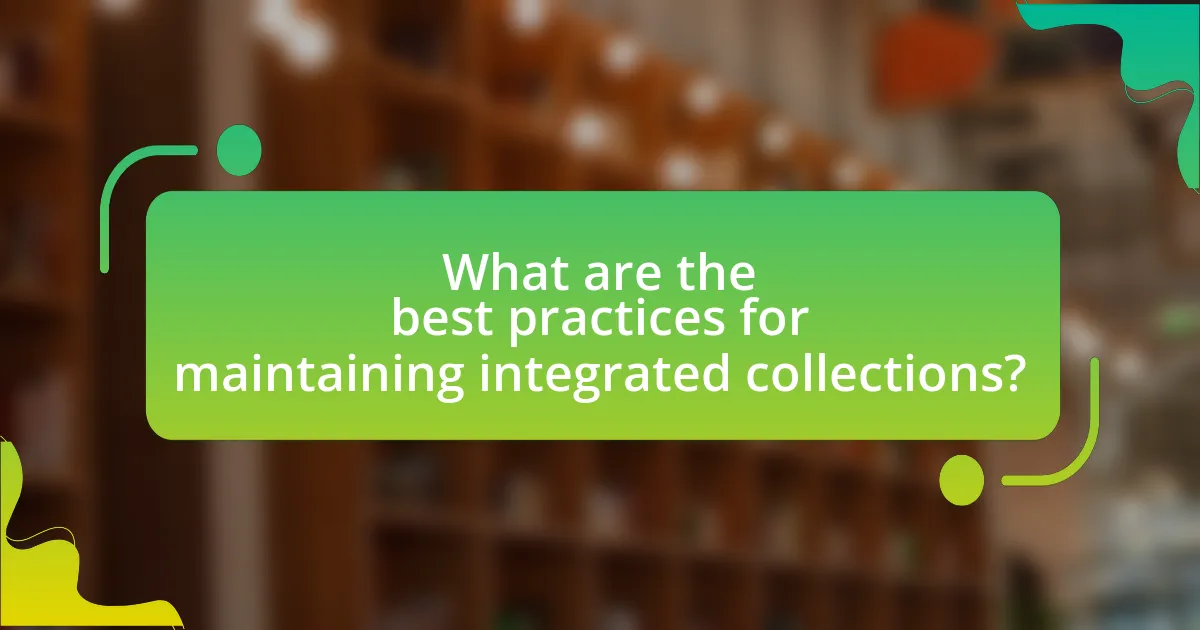
What are the best practices for maintaining integrated collections?
The best practices for maintaining integrated collections include regular assessment, consistent metadata standards, and user engagement. Regular assessment ensures that the collections remain relevant and up-to-date, allowing for the identification of gaps or outdated materials. Consistent metadata standards facilitate easier access and retrieval of information across both digital and traditional resources, enhancing user experience. Engaging users through feedback mechanisms helps libraries understand their needs and preferences, leading to more effective collection management. These practices are supported by studies indicating that libraries employing systematic assessment and user feedback report higher satisfaction and usage rates among patrons.
How can libraries ensure the sustainability of integrated resources?
Libraries can ensure the sustainability of integrated resources by implementing a strategic framework that includes regular assessment, collaboration with stakeholders, and investment in technology. Regular assessment allows libraries to evaluate the usage and relevance of both digital and traditional resources, ensuring they meet user needs effectively. Collaboration with stakeholders, such as publishers and technology providers, fosters partnerships that can enhance resource sharing and reduce costs. Investment in technology, including robust digital infrastructure and user-friendly interfaces, supports seamless access to integrated resources, thereby increasing user engagement and satisfaction. These strategies collectively contribute to the long-term viability of integrated library resources.
What role does staff training play in successful integration?
Staff training is essential for successful integration of digital collections with traditional library resources. Effective training equips staff with the necessary skills and knowledge to navigate and manage both digital and physical resources, ensuring seamless access for users. Research indicates that libraries that invest in comprehensive staff training programs experience higher user satisfaction and improved resource utilization. For instance, a study by the American Library Association found that libraries with well-trained staff reported a 30% increase in user engagement with digital collections. This highlights the critical role of staff training in enhancing the overall integration process.
How can user feedback be utilized to improve integrated collections?
User feedback can be utilized to improve integrated collections by systematically gathering insights on user experiences and preferences regarding both digital and traditional resources. This feedback allows libraries to identify gaps in their collections, understand user needs, and prioritize enhancements based on actual usage patterns. For instance, a study by the American Library Association found that libraries that actively solicited user feedback saw a 30% increase in user satisfaction and engagement, demonstrating the effectiveness of incorporating user input into collection development strategies. By analyzing this feedback, libraries can make informed decisions about resource allocation, ensuring that integrated collections meet the evolving demands of their users.
What common pitfalls should libraries avoid during integration?
Libraries should avoid inadequate planning during integration, as it can lead to misalignment between digital collections and traditional resources. Insufficient stakeholder engagement often results in overlooking user needs, which can diminish the effectiveness of the integration. Additionally, neglecting to establish clear technical standards can create compatibility issues, hindering seamless access to resources. A lack of training for staff on new systems can also impede the successful adoption of integrated services. Research indicates that libraries that prioritize comprehensive planning, stakeholder involvement, and staff training experience significantly smoother integration processes, ultimately enhancing user satisfaction and resource accessibility.
How can libraries address issues of accessibility in integrated resources?
Libraries can address issues of accessibility in integrated resources by implementing universal design principles and providing assistive technologies. Universal design ensures that resources are usable by all individuals, regardless of their abilities, by incorporating features such as screen readers, alternative text for images, and keyboard navigation. Additionally, libraries can offer assistive technologies like magnifiers and adaptive software to enhance access to both digital and traditional resources. Research indicates that libraries that adopt these strategies see increased user engagement and satisfaction, demonstrating the effectiveness of these approaches in improving accessibility.
What strategies can mitigate the risk of resource duplication?
Implementing a centralized resource management system can effectively mitigate the risk of resource duplication. This system allows libraries to catalog and track both digital and traditional resources in one unified platform, reducing the chances of acquiring or maintaining duplicate materials. Research indicates that libraries utilizing integrated library systems report a significant decrease in resource redundancy, as these systems provide real-time data on existing collections and facilitate better decision-making regarding acquisitions. Additionally, regular audits of collections can identify duplicates, ensuring that libraries maintain an efficient and streamlined inventory.
What practical tips can libraries implement for successful integration?
Libraries can implement several practical tips for successful integration of digital collections with traditional resources. First, they should conduct a comprehensive assessment of existing resources to identify gaps and overlaps, ensuring that both digital and physical collections complement each other. This assessment can be supported by usage statistics, which reveal user preferences and inform collection development strategies.
Second, libraries should invest in user-friendly technology that facilitates access to both digital and traditional materials, such as integrated library systems that allow seamless searching across formats. Research indicates that libraries utilizing such systems see increased user engagement and satisfaction.
Third, staff training is essential; librarians must be equipped with the skills to assist patrons in navigating both digital and physical collections effectively. Studies show that well-trained staff can significantly enhance user experience and resource utilization.
Finally, libraries should promote their integrated collections through outreach and marketing efforts, utilizing social media and community events to raise awareness. Evidence from library outreach programs demonstrates that increased visibility leads to higher usage rates of both digital and traditional resources.
